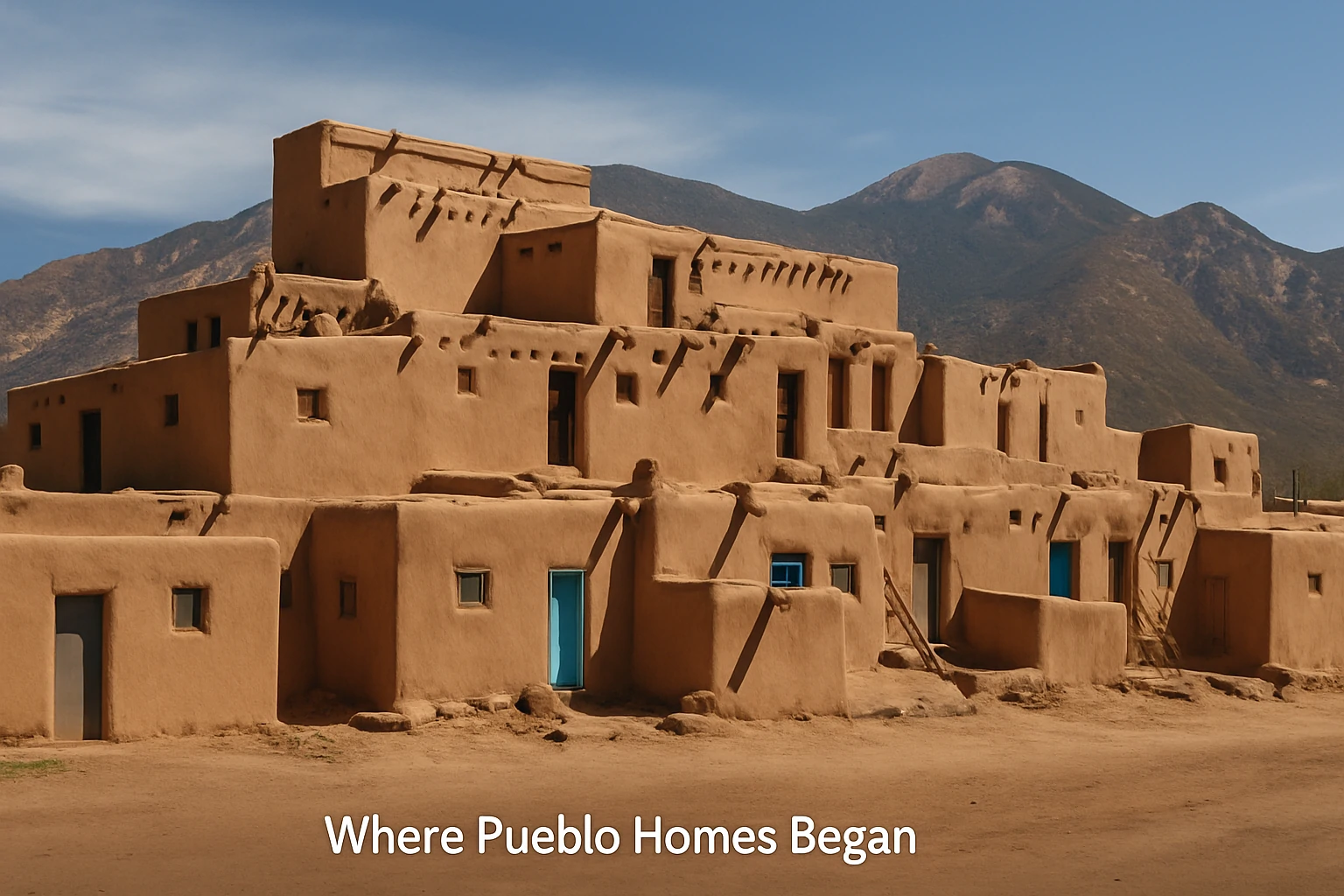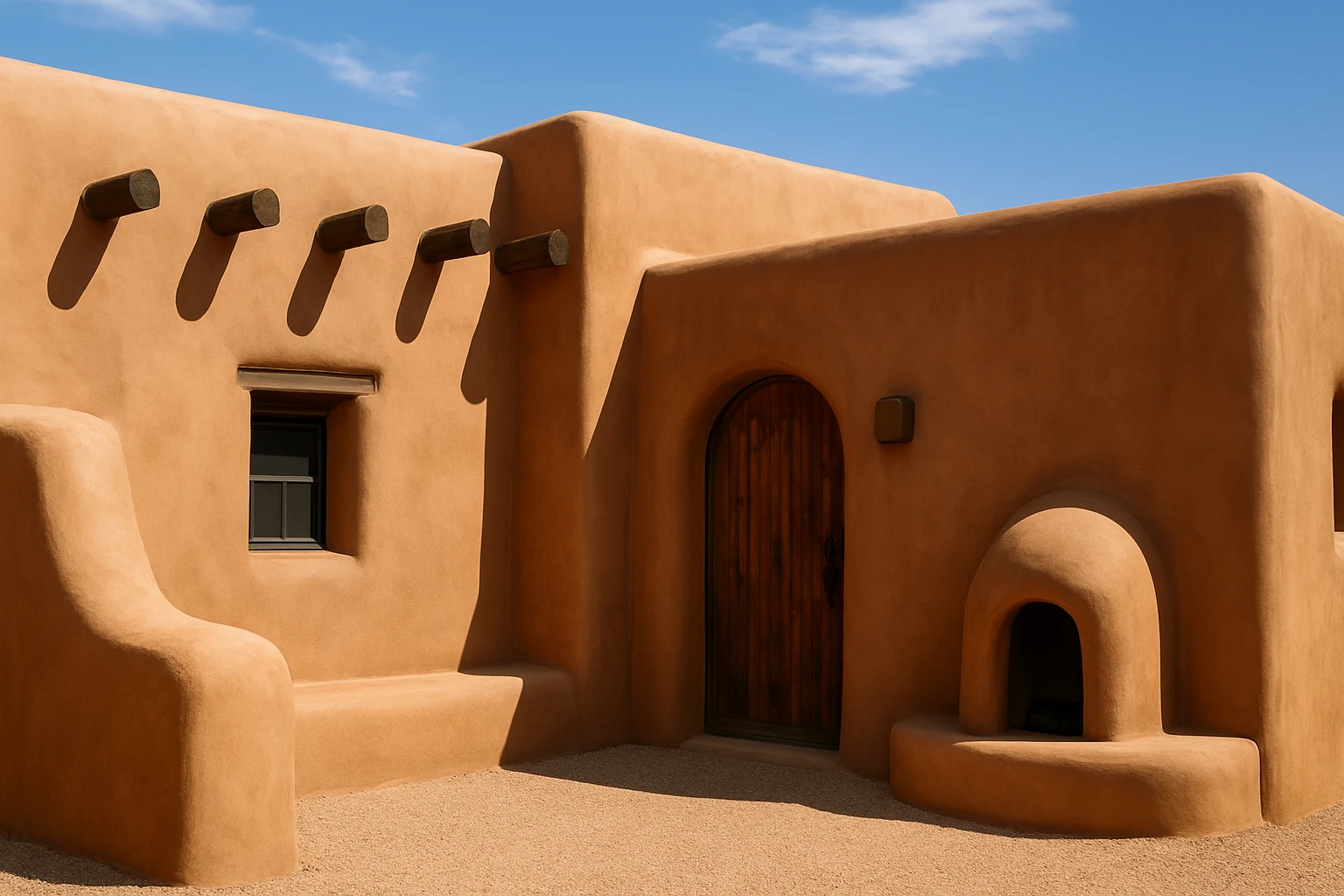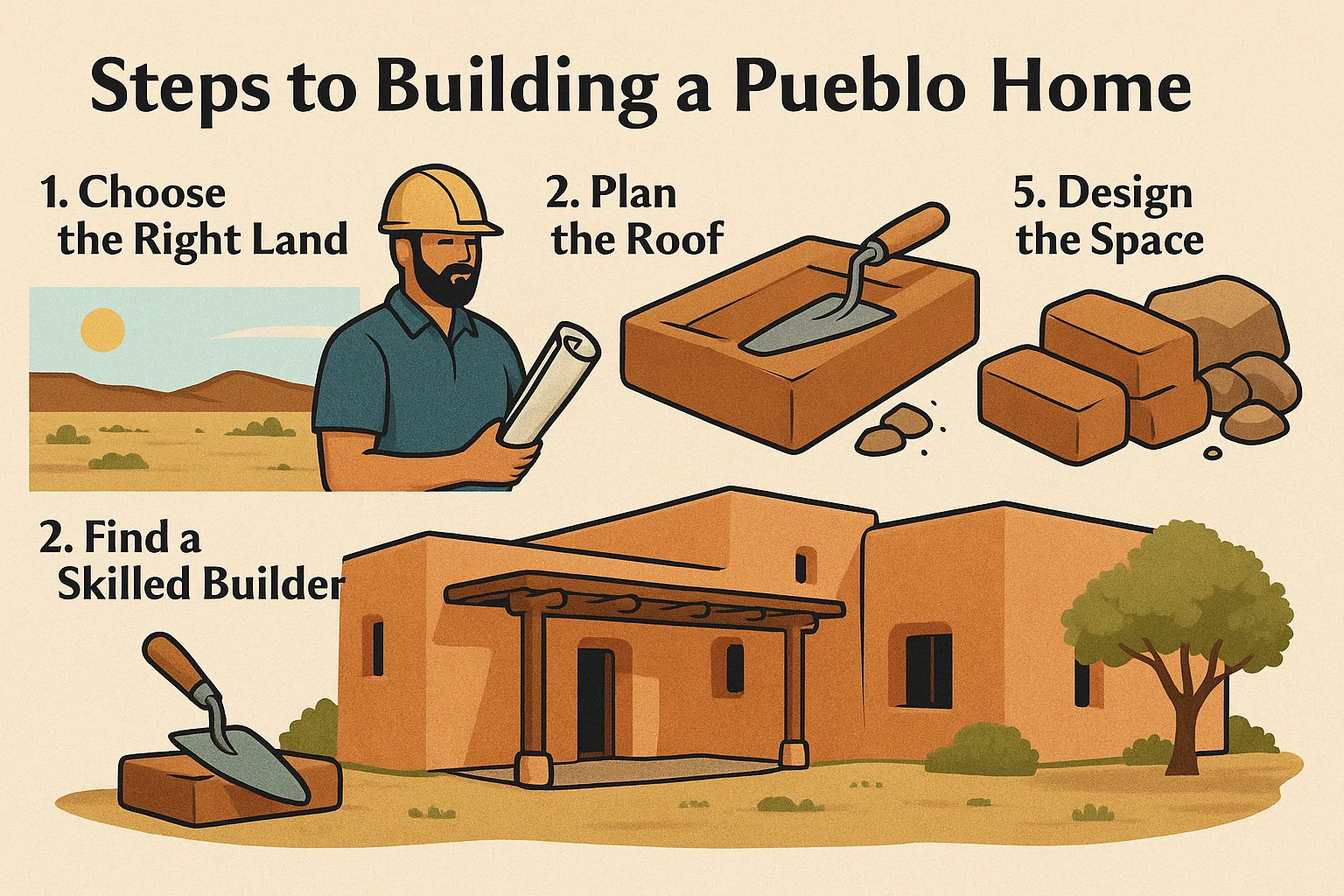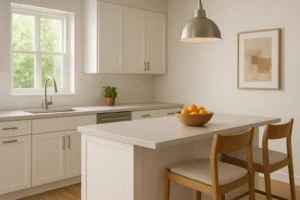Pueblo style homes offer more than walls and roofs. They give people a sense of place, peace, and purpose. These homes come from the American Southwest, where early native builders shaped homes from clay, earth, and stone. The design does not follow trends. It rises from the land, shaped by nature and time. Every wall, beam, and doorway in a Pueblo home speaks with quiet strength. You do not see steel or glass towers here. You see thick earth walls, soft corners, and colors that match the desert ground.
These homes began in dry regions where resources were limited. People built with what they had. They used the sun to dry bricks. They used wood from nearby trees to support the roof. The design came from need, not from style. But through this need, a lasting beauty formed. The homes stood low to the ground. They stayed cool in summer and warm in winter. Their windows remained small, deep, and shaded. Their flat roofs collected little rain and made use of the open sky.
Over time, Spanish settlers came to the Southwest. They did not tear down what existed. Instead, they added to it. They shaped courtyards and placed carved wood into the design. Their doors brought new patterns. Their tools gave more texture to walls and walkways. The blend of cultures gave rise to what we now call Pueblo Revival. The homes stayed simple. The shapes remained true. The style became stronger with every layer.
In the early 1900s, architects across the Southwest began to look back. They wanted to build homes that made sense for the land. returned to thick walls, wood beams, and smooth clay surfaces. They moved away from modern boxes and glass towers. The earth-tone walls and flat roofs returned. The revival brought pride and focus. Pueblo style became a symbol of the region. It honored those who came first. It respected the land’s color, shape, and silence.
People today still find comfort in Pueblo homes. These houses stay cool in the heat. They hold warmth at night. They block outside noise. Their thick walls offer more than support. They offer calm. Every room feels solid. Each space flows into the next. The quiet curves guide the eyes and slow the mind. A person does not rush through a Pueblo home. They move with ease and stay a little longer they notice the way the light lands on the floor.
The design fits best in dry areas, but the feeling can live anywhere. You do not need to live in New Mexico to enjoy Pueblo style and you can add it in small ways or large ones, you can paint with warm earth tones and you can round the corners of your walls and you can build with clay, wood, and stone. You can shape a home that feels honest, strong, and safe. This article will help you understand the history, structure, and beauty of Pueblo homes. It will also guide you if you want to buy, build, or adapt this style in your own space.
Where Pueblo Homes Began

The roots of Pueblo homes reach deep into North American history. Long before cities rose and highways stretched across states, Pueblo people built homes from soil and sun. They gathered earth and straw and added water. They pressed this mix into blocks and laid them out to dry. This method did not need machines. It did not cost much. It used only what the land gave.
These early homes stacked high in clusters. Some had many floors. Others hugged the earth in long rows. They shared walls and courtyards. They formed tight-knit spaces that helped families stay close and cool. Small windows helped block the desert sun. Thick walls held in warmth through cold nights. Every choice had a reason. No space was wasted. No part stood out just to impress.
The Spanish brought horses, new tools, and fresh building ideas. They saw the value in adobe walls and earthen shapes. They kept the flat roofs and small windows. But they added carved doors, colorful tiles, and walled gardens. These touches added beauty but stayed true to the old form. The homes still blended with the desert. They still followed the sun.
This blend formed the foundation of the Pueblo Revival style. Even as towns grew and new materials became common, this design stayed alive. In Santa Fe and Taos, the style never left. It remained the soul of the place. People still live in homes passed down from one generation to the next. The buildings carry memory and meaning.
In modern times, architects revived the style with pride. They wanted to return to walls that felt strong and roofs that welcomed stars and moved away from metal and mirrors. They chose mud, wood, and stone. The homes fit the land again. Builders stopped trying to force the land to fit the home.
What Makes Pueblo Homes Unique
Pueblo homes do not rely on decoration to make their mark. They speak through shape, texture, and honesty. Each part of the home fits a purpose and fits the land.
Adobe walls give Pueblo homes their strength and comfort. These walls are thick and solid. They hold heat in winter and block it in summer. The surface often feels smooth, but small waves and lines show that hands shaped it. In many homes, plaster or limewash covers the adobe, keeping the wall protected from sun and rain.
Flat roofs help the home stay low and grounded. These roofs often have a slight slope to drain water. Some homes use roof spouts or canals to guide water off the edges. The roof does not rise or pull focus. It rests, quiet and simple.
Wooden beams called vigas stretch across the ceiling and poke through the outer walls. You can see each beam from outside the house. These beams show how the roof holds itself. They give rhythm to the line of the house. Inside, smaller sticks may cross between them, forming a woven roof ceiling called latillas.
Corners do not cut sharply. They round and bend with ease. You do not see sudden angles. You see soft turns and natural flow. Each curve makes the house feel calm.
Windows stay small and sit deep within the walls. This helps shade the inside and keep it cool. Light enters in slow streams. Some windows may have shutters or wood trim. Others remain plain. The deep sills give space for pottery, plants, or books.
Colors never scream. Most Pueblo homes use earth tones. Walls may show clay red, dusty brown, or soft tan. These colors match the land. They reflect the sun instead of absorbing heat. Together, these shades make the home feel quiet and rooted.
Every piece works together. The walls, the roof, the beams, and the windows do not fight for attention. They flow as one. Pueblo homes do not chase style. They hold to truth. They last because they make sense.
“If you enjoy traditional home styles with deep cultural roots, you may also appreciate the charm of a Clapboard Home Design for its classic lines and historical character.”
The Shape and Feel of Pueblo Design

When you walk toward a Pueblo style home, you notice the soft lines first. The walls do not rise in sharp corners. They curve gently. The roof does not slope steeply. It stays flat, like a sheet of sand. Wooden beams stretch through the roofline and reach past the walls. These beams are not hidden. They show the work. They show the weight.
The color of the home blends with its setting. Most use warm shades of brown, tan, or clay red. These colors reflect the land and calm the eyes. You do not see bright paint or harsh trim you see earth and see dust you see sky reflected in stone. That quiet palette brings peace. It invites, not demands.
Windows remain few and small. They sit deep in thick walls. This depth helps keep the heat out. It also softens the light that comes in. Every beam of sunlight feels earned. Every corner feels cool. These homes never try to shine too bright. They shine in their stillness.
Inside, rooms flow without hard stops. One space leads to another. Courtyards open to the sky but feel safe. Floors use tile, brick, or smooth stone. Walls wear natural textures. Ceilings may show wood beams, sometimes whitewashed or left raw. The shape holds you. It does not push.
The fireplaces curve like domes. They do not jut out or shout they rest in corners or against long walls they serve the room without cutting through it They warm without burning space.
Why the Style Still Works
A Pueblo home does not age. It deepens it does not go out of style and It stays in place. The design does not seek change. It already works. The walls hold heat when the night turns cold. They stay cool when the sun stands high. The flat roof lets you walk close to the sky. The rooms keep quiet even when life outside makes noise.
These homes do not crumble with time. Adobe lasts when treated with care. It does not burn it does not rot in dry air and it does not fall when the wind howls. Some homes built more than a century ago still stand. The roof may need work. The plaster may crack. But the bones stay firm. The house keeps its shape.
Pueblo homes also block sound. The thick walls mute the world outside. Voices stay in their room. Each space feels private. The quiet soothes your thoughts. The light touches the floor with grace. You feel the pace shift you breathe slower and You see more.
These homes feel honest. You see how they stand. The beams show. The roof lies flat. The doors stay low. The walls hold weight. You know what the home offers because it shows you. That truth earns trust. That form builds peace.
Common Mistakes
| Mistake | Why It Hurts the Design |
|---|---|
| Using Fake Stucco Over Thin Walls | Thin walls covered with modern stucco do not hold heat or block sound. They only copy the look, not the function. |
| Skipping Drainage on Flat Roofs | Flat roofs need a slight slope and working drains. Without them, water pools and leaks form. The roof weakens fast. |
| Installing Large Glass Windows | Big windows break the flow and invite too much sun. Pueblo homes use small, deep-set windows for shade and comfort. |
| Choosing Bright or Modern Colors | Harsh colors clash with the style. Pueblo homes look best in earth tones that match clay, sand, and sky. |
| Leaving Out Natural Materials | Plastic trim or metal siding feels fake. Clay, stone, wood, and plaster keep the home honest and grounded. |
| Ignoring Wall Texture and Shape | Flat surfaces and sharp corners remove the style’s charm. Rounded edges and hand-finished walls bring life and warmth. |
| Over-decorating the Exterior | Extra fixtures, modern lights, or busy trim distract from the simple lines. The home should rest in the land, not fight it. |
| Skipping Courtyard Space | A flat front with no courtyard breaks the feel of the home. Even a small walled garden adds privacy and tradition. |
Steps to Building a Pueblo Home

If you dream of building a Pueblo home, you need the right land. The ground must stay dry. Wet soil breaks adobe. Hills may lead water toward the walls. Choose a flat, open space. Let the land breathe. Let it drain.
Find a builder who knows the form. Do not settle for someone who copies the look. You need skill, not style. The walls must be thick. The corners must round. The beams must hold real weight. A shallow frame with paint cannot stand like adobe.
Plan the roof. Flat does not mean level. It must slope enough to move water. Add drains. Add spouts. Let water leave. Keep it from the walls. Use gravel paths or stone borders to guide flow. The roof must protect, not collect.
Use local materials. Let the home borrow from the land. Clay, sand, wood, and stone serve best. They cost less and match better. Use reclaimed wood for beams and doors. Let the grain show. Let knots stay. Do not cover the truth.
Design the space around light and air. Use courtyards. Keep rooms open. Let each window serve a clear purpose. Avoid clutter. Avoid tricks. Keep the lines simple. Let the home feel like it always stood there.
How to Maintain a Pueblo Style Home
A Pueblo home can last for generations if cared for with patience and attention. These homes may look strong, but they depend on steady upkeep. The walls, roof, and beams all need regular checks. When treated well, they stay firm and safe for many years.
The flat roof demands the most care. It needs a clean surface and clear drains. Even a small puddle can cause trouble. After each season, remove dust, leaves, and debris. Make sure canales or roof spouts stay open. Look for soft spots or cracks in the coating. A sealed roof will protect the rest of the house.
The walls need inspection too. Adobe and stucco both crack over time. A small crack can grow if ignored. Use natural plaster or lime wash on adobe walls to keep them healthy. On stucco, use patch mix to fill small gaps. Never cover cracks with paint alone. The wall must breathe, and heavy paint traps moisture.
Wood beams bring charm but need attention. Keep them dry and sealed with natural oils or wax. Do not use thick paint or plastic coating. That kind of seal traps moisture and weakens the wood. Watch for signs of termites or rot near the ends of the beams. If the wood darkens or smells damp, call a carpenter to check it.
Drainage around the home also matters. Water should flow away from the base, not toward it. Add gravel or stone paths near the walls to guide rainwater out. Check the soil level. If dirt or plants touch the wall, trim them back. Moisture can sneak in through the ground.
Inside the home, keep the air dry but gentle. Avoid harsh cleaners on plaster or tile. A damp cloth with mild soap works best. If the home has tile floors, re-seal the grout once a year. Sweep dust from courtyards and patios. Clean the fountains and drains often to stop buildup.
Light repairs done often cost less than one large repair later. A Pueblo home rewards care. When the owner respects its needs, the house gives back in strength and beauty. These homes do not need constant work, only steady care. A clean roof, a dry beam, and a patched wall keep it whole for decades.
Pueblo Style Homes Across the U.S.

Pueblo homes began in the American Southwest, but their reach now spreads far beyond their native soil. The style found its first stronghold in New Mexico, where it still thrives today. Cities like Santa Fe and Taos protect the look through strict building codes. New homes must follow the old shapes. Flat roofs, adobe walls, and rounded corners stay required in many areas. These towns do not treat Pueblo design as decoration. They treat it as identity.
In Albuquerque, the largest city in New Mexico, Pueblo Revival homes appear in both historic and modern neighborhoods. Local builders respect tradition but add new touches. They use modern materials but keep the same forms. You see homes with solar panels and floor heating, yet they still carry thick stucco walls and wood-beam ceilings.
Across the border in Arizona, cities like Tucson and Scottsdale also feature Pueblo-inspired architecture. The dry climate supports this form. Builders use adobe, rammed earth, or synthetic stucco. Even high-end homes in desert neighborhoods follow this look. The colors blend with the desert. The shape matches the light.
In California, Pueblo homes appear in areas with strong Spanish or Native roots. You may see them in Palm Springs, Santa Barbara, and parts of Los Angeles County. These homes often mix Pueblo shapes with Spanish tile and mid-century lines. The result still feels grounded and warm.
Parts of Colorado, such as Durango and Pueblo, also honor the tradition. The climate fits, and local builders understand how to make the walls thick, the roofs flat, and the space quiet.
Smaller towns in Texas, Nevada, and Utah have adopted this style as well. Even in the High Desert of Oregon, a few homes follow this path. Builders in these regions use the shape but adjust the materials to resist more rain or colder winters.
No matter where they appear, Pueblo homes keep the same voice. They speak softly and settle into the land.They show respect for the place and the people who came before.
Ways to Bring Pueblo Touches to Any Home
Not everyone can build from the ground up. But anyone can bring Pueblo charm to a space. Start with color. Paint walls in clay tones. Use matte finishes. Add wood beams or thick trim. Use rough wood. Let it stay warm and real.
Curve sharp corners. Use plaster or drywall to soften lines. Add tile or brick floors. Choose rugs with earth patterns. Add pots made from clay. Keep art simple. Let each piece breathe.
Build a small courtyard if you have the space. Use walls to shape a square of quiet. Add a tree, a bench, and a fountain. Let the wind pass the light shift your home rest.
Shape a fireplace like a kiva. Use rounded forms. Place it low. Let it rise like a hill inside your room. Choose simple brick or smooth clay. Let the fire glow, not flash.
Use windows with deep frames. Let the sun enter slow. Use shutters if you like. Add light, not glare.
Final Thoughts
Pueblo homes do not chase the future. They stand with the past they remind us to stay rooted show us that strength can feel soft. That silence can speak home can mean peace.
You do not need to live in the desert to love this style. You only need to want truth in your walls and calm in your air. Pueblo homes give both. They give more than shape. They give a way to live.
If you choose this path, you choose a home that respects time, place, and purpose. You choose to build with care, not speed. You choose to let your home rise from the land-not sit on top of it.
“Not everyone wants to build from scratch. Some buyers explore options like a spec house to get a move-in ready home without the wait.”




